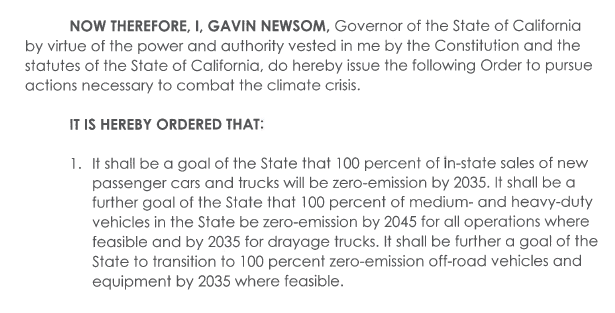1. Check out my latest on California's cap-and-trade program:
https://twitter.com/Gary_C_Reed/status/1266452659269103618
2. At the quarterly auction last week, the state collected only $25M instead of the usual $600-800M. Why? lao.ca.gov/LAOEconTax/Art…
3. The answer is simple—the program has too many allowances.
4. A little background: it's an old problem, common to environmental markets around the world. This is the second time in four years California has had a revenue shortfall as a result of having too many allowances. 

5. Legislation in 2017 extended the program to 2030 and put the auctions back on track. It also required the regulator, CARB, to "evaluate and address" the excess allowance problem. Guess what happened?
6. CARB put out some bad numbers to justify taking no action—demonstrably false and totally beneath the agency's hard-earned reputation. CalMatters' @julie_cart covered the exchange here: calmatters.org/environment/20…
7. So having kicked the can down the road, CARB ended up with a market design that looked, in every practical respect, like the oil industry's wish list (cc @RL_Miller). Way better than nothing, but far less than what's needed for the state's climate goals.
9. In one fell move, big oil rolled back local air districts' climate authority, prevented new statewide regulations on the oil and gas industry, and locked in an oversupplied cap-and-trade program. ProPublica's @lisalsong has the whole story here: propublica.org/article/cap-an…
10. To be fair, compromise was always going to be necessary. Thanks to an industry-funded ballot initiative (Prop 26), market-based climate policies require a 2/3 vote in California. There's no path to 2/3 in any jurisdiction that doesn't give incumbent polluters a voice.
11. And along with the cap-and-trade bill came a companion effort, AB 617, to invest in local air quality improvements. The two bills were joined together to symbolize the commitment to climate and clean air.
12. But critically, the deal on both climate and air quality depended on stable revenue. An oversupplied market would sell climate policy short, but bring in enough money to keep California's environmental programs running. For some, that was enough. A down payment, perhaps.
13. Problem is, CARB's approach to keeping industry happy was to maintain an oversupplied market to keep prices artificially low. That approach worked … until it didn't.
14. In early March, the secondary market for allowances went haywire when investors dumped their holdings and crashed the secondary market price. That's bad news for the government's quarterly allowance auctions, which raise the state's climate and clean air funds.
15. Because the quarterly auctions have a minimum price—the market's "price floor"—secondary market price crashes tend to depress demand at auctions, leading to the revenue shortfalls we saw in 2016-17 and again this week.
16. Now—in the middle of a massive budget crisis—the state's climate funds are nowhere to be seen, and long-term market prices indicate the problem could come back again in the next quarterly auction in August.
17. A lot of people want to blame this outcome on COVID—i.e., "who could have known?!?" But GHG emissions aren't falling that much. Compared to the scale of market oversupply, the likely drop in 2020 emissions is tiny. See here for The Science: ghgpolicy.org/writing/2020/5…
18. The fact is that hedge fund margin calls and macroeconomic shocks wouldn't crash a market if it were well-designed. The EU ETS and RGGI learned the hard way about the importance of designing markets to anticipate and weather unexpected storms. But they did learn.
19. So far, CARB has been unwilling to admit its mistake. What's so frustrating is that the warning signs have been out there for years. Among the first to raise the alarm were @chrisbbusch and @JustinHGillis: nytimes.com/2017/12/12/opi…
20. Academics have been writing about these risks, too—notably @BorensteinS, Jim Bushnell, Frank Wolak, and Matthew Zaragoza-Watkins: aeaweb.org/articles?id=10…
21. Mike Mastrandrea, @masoninman, and I showed the extent of excess allowance accumulation exceeded regulator's worst-case scenario in 2018 and matched projections from @chrisbbusch, the Ontario Government, and @LAO_CA: iopscience.iop.org/article/10.108…
22. We also developed an open source model that shows these conditions could cause the program to be "long" on allowances all the way through 2030—even before COVID pushed emissions lower: tandfonline.com/doi/abs/10.108…
23. Anyway, there a bunch of ways to fix the problem. We all have an interest in seeing a better program—one that's more reliable for cutting climate pollution, generating revenues for public programs, and yes, even stabilizing compliance costs for industry.
24. But that all depends on CARB and the Newsom Administration wanting to make a change. Here's hoping they will.
* fin *
* fin *
25. … adding, it takes a village to cover an issue this complicated, and I forgot to mention several key voices. @jacqules wrote a great summary of the situation in the @latimes in January: latimes.com/opinion/story/…
26. Last year, @RA_Becks had a great @CalMatters story on an excellent and brave @Next10 report warning about the slack pace of climate policy progress in recent years: calmatters.org/environment/20…
27. And last but not least, @KateAronoff was on this way back in the day, writing about the actual legislative horse-trading for @inthesetimesmag: inthesetimes.com/article/20331/…
28. A lot of people dismissed @KateAronoff for political bias on that story, but for my money, it's the single best example of California climate journalism in 2017. Kate makes no secret of her political views; #climatetwitter should make no secret of her prescience, either.
• • •
Missing some Tweet in this thread? You can try to
force a refresh






